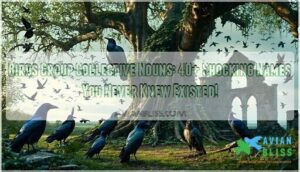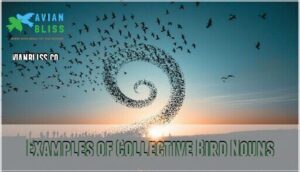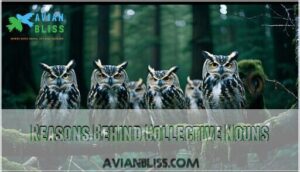This site is supported by our readers. We may earn a commission, at no cost to you, if you purchase through links.

You’ve got classics like a "murder of crows" (creepy, right?) or a parliament of owls (they do look wise).
Some reflect behavior—like a murmuration of starlings, describing their mesmerizing swarm patterns.
Back in medieval times, nobles used these terms to sound fancy, thanks to books like The Book of Saint Albans.
While scientists stick to "flock" for simplicity, these quirky names bring charm to birdwatching, making it a fun way to connect with the feathered world, and next time you see geese, call them a gaggle.
Table Of Contents
- History of Collective Nouns
- Examples of Collective Bird Nouns
- Reasons Behind Collective Nouns
- Scientific Relevance and Usage
- Notable Examples of Collective Nouns
- Crows – a Murder of Crows and Its Origins
- Owls – a Parliament of Owls and Its Significance
- Starlings – a Murmuration of Starlings and Its Beauty
- Other Notable Examples of Collective Nouns
- Cultural Significance of Collective Nouns
- What are some collective nouns for birds?
- Are there different names of a group of different birds?
- What is an example of a group of birds?
- What are avian collective nouns?
- What is a group name for a bird?
- What is the collective noun for a group of crows?
- What is a cluster of birds called?
- What are birds called collectively?
- What group of birds is called a party?
- What is a Congress of birds?
- Conclusion
History of Collective Nouns
You’ll find that most bird collective nouns began in medieval times when nobles created these fancy terms to show off their education during hunting trips.
These quirky names, like "a murder of crows," first appeared in hunting guides like The Book of Saint Albans from 1486 and have stuck around because they’re just so fun to say, making them a lasting part of our language.
Origins in The Middle Ages
Hunting terminology used to describe bird groups sprouted from medieval times around the 14th century.
These collective noun origins are further explored on Avian Bliss.
You’d be surprised how these terms of venery weren’t just practical—they showcased social hierarchy among nobles.
When you went hunting back then, knowing whether to call it a "murder of crows" or a "parliament of owls" separated the aristocrats from commoners.
This linguistic decadence became part of nobility’s exclusive world of ornithology knowledge.
Influence of The Book of Saint Albans
The landmark Book of Saint Albans, printed in 1486, revolutionized how we talk about bird groups.
This medieval text cemented the linguistic legacy of collective nouns that you still use today. Crows exhibit complex social structures and behaviors.
Here’s what made it so influential:
- Listed 165 original collective nouns for animals
- Popularized terms like "murder of crows" and "gaggle of geese"
- Connected hunting terminology to everyday speech
- Preserved medieval bird lore for centuries
- Created a formal system for venatorial culture and terms of venery
Role in Distinguishing The Aristocracy
You’d be amazed how collective nouns for birds weren’t just cute names, but powerful tools of social division.
In medieval times, knowing these terms separated the nobles from commoners. A charm of finches, an exaltation of larks, or a parliament of owls are just a few examples of these unique collective bird names.
The Book of Saint Albans preserved these distinctions, making language itself a social ladder everyone had to climb, highlighting the **power of
Evolution of Collective Nouns Over Time
Over five centuries, collective nouns for birds have undergone fascinating linguistic shifts.
What began as exclusive hunting terminology in medieval courts has transformed through societal influence and changing perceptions.
Terms of venery from The Book of Saint Albans evolved from practical identification to cultural touchstones.
While "a murder of crows" retains its medieval charm, modern usage has introduced new ornithology terms reflecting our deepening understanding of bird behavior.
You’ll notice these collective nouns continue evolving, blending tradition with contemporary observation, and this blend is a key part of their fascinating nature.
Examples of Collective Nouns in Modern Times
You’ll frequently encounter fascinating bird collective nouns in modern usage.
From a "murder of crows" to a "parliament of owls," these unusual bird group names have found their way into everyday language, social media, and literary applications.
Popular examples like a "murmuration of starlings" don’t just sound poetic—they actually describe how these birds move together in mesmerizing patterns.
These interesting collective nouns for birds enhance your birdwatching experience and are a "parliament of owls" worth exploring.
Examples of Collective Bird Nouns
You’ll find over 40 unusual collective names for birds that’ll surprise you, from a "murder" of crows to a "parliament" of owls.
When you spot a group of starlings swirling in the sky, you’re actually witnessing a "murmuration", just one of many fascinating terms bird watchers use.
Waterbirds – Colonies, Rafts, and Coverts
When you spot a group of waterbirds, you’re witnessing nature’s poetry in motion – each gathering has its own special name!
- A raft of ducks floating peacefully on water
- A colony of penguins huddled together on shorelines
- A covert of coots hiding among reeds in waterfowl habitats
Diving ducks form "doppings" when submerging, while pelicans gather in "pods" along coastal colonies.
Next time you’re lakeside, impress friends by correctly naming these graceful flocks!
Songbirds – Charms, Flights, and Murders
Songbirds gather in groups with names as melodious as their tunes. When finches flock together, they form a "charm" – perfectly capturing their colorful, cheerful nature.
You can find a variety of songbird collective noun products online.
A "murmuration" of starlings creates breathtaking aerial ballets across the sky. A "watch" of nightingales reflects their evening serenades. A "blush" of robins symbolizes their distinctive red breasts.
Crows, despite their intelligence, get the ominous "murder" label, while swallows cruise in "flights" or "gulps." These collective nouns for birds aren’t just labels – they’re poetry in motion.
Birds of Prey – Wakes, Parliaments, and Eyries
When you explore raptor terminology, you’ll find these magnificent birds of prey boast some of the most intriguing collective nouns in the avian world.
The collective nouns for different bird types are as follows:
A wake of vultures, a cast of falcons, or a convocation of eagles each reflects these predators’ social structures and powerful presence in nature.
Game Birds – Coveys, Bevy, and Plump
Game birds’ collective nouns tell us fascinating stories about their behavior.
When you’re out hunting, you might spot a covey of quail or partridges – the most common term used for these ground-dwelling birds.
A bevy of quail suggests a beautiful gathering, while a plump of waterfowl hints at their well-fed appearance.
You can find game birds collective noun products.
Other game bird examples include a nye of pheasants and a rafter of turkeys.
These hunting terminology terms weren’t just random choices!
The covey definition relates to how these birds huddle together, while bevy usage emphasizes their attractive grouping.
Next time you’re outdoors, try identifying these collective nouns in action – they’ll enhance your wildlife watching experience!
Unique Collective Nouns for Specific Bird Species
While game birds gather in familiar coveys and plumps, you’ll be amazed by the jaw-dropping collective nouns for specific bird species.
Ever heard of an "ostentation of peacocks" or a "pandemonium of parrots"? These names perfectly capture their personalities! Understanding the unique characteristics of bird species traits can provide insight into how these collective nouns originated.
These unique bird groups’ names aren’t just random – they reflect centuries of observation, revealing how our ancestors saw each bird’s distinctive character.
Reasons Behind Collective Nouns
You’ll find that most bird collective nouns come from careful observation of their behavior, appearance, or the sounds they make.
When you look at terms like a "murmuration" of starlings or a "parliament" of owls, you’re seeing centuries of human connection with these creatures expressed in just a single, perfect word.
Descriptive and Intriguing Names
Having explored popular bird group names, let’s look at why some collective nouns are so enchanting.
These descriptive names paint vivid pictures of our feathered friends:
A charm of finches flutters through the trees, their vibrant colors and cheerful songs filling the air with delight.
- A murder of crows reflects their ominous gathering habits
- An exaltation of larks captures their uplifting songs
- A parliament of owls suggests their wise, deliberative appearance
- A pandemonium of parrots perfectly describes their noisy, colorful chaos
These names aren’t just labels—they’re tiny poems that bring bird watching to life!
Reflection of Bird Behavior and Appearance
While bird names often sound poetic, they’re also practical mirrors of how birds actually behave and look in nature.
Ever noticed how collective nouns for birds perfectly capture what makes each species special? These names aren’t random – they’re inspired by flock dynamics, plumage patterns, and bird behavior that’s easy to observe.
You’ll find these bird group names make birdwatching even more fun when you understand the connection between the name and what you’re seeing, and how they reflect the unique characteristics of each bird species, making the experience more enjoyable and informative.
Humorous and Whimsical Names
Diving into the realm of bird group names, you’ll discover the truly hilarious side of ornithology.
These whimsical groupings aren’t just scientific—they’re downright entertaining!
5 side-splitting collective nouns you’ll love:
- A "confusion" of guinea fowl
- A "pandemonium" of parrots
- A "murder" of crows
- A "mischief" of magpies
- A "conspiracy" of ravens
You’ll never look at bird groups the same way again, and the discovery of these whimsical groupings will leave you with a lasting impression!
Names Based on Bird Habits and Physical Characteristics
While listening to birdsong, you’ll notice collective nouns often capture physical traits and behaviors that make each species unique.
Bird group names reveal fascinating connections to their natural habits:
- A "murmuration" of starlings reflects their synchronized flight patterns
- A "plunge" of pelicans describes their dramatic diving technique
- A "drumming" of woodpeckers highlights their percussive nesting habits
- A "huddle" of penguins showcases their flock formations for warmth
Names Reflecting Beliefs About Bird Personalities
Ever wonder about bird group names? Owls get "parliament" for their "wisdom," while crows earn "murder" for their cunning reputation.
Ravens evoke "mystery," swans reflect "grace," and jays show "boldness."
These odd collective nouns for birds mix myths and traits, giving fun labels that stick.
Some cultures have various bird superstitions about different species.
Check a bird group names list—it’s like a collective nouns birds quiz to explore the cunning reputation of certain bird species!
Scientific Relevance and Usage
You might think scientists use quirky bird group names like "murder" or "murmuration," but they usually don’t.
They stick to simple terms like "flock" to keep things clear and precise.
Limited Use in Scientific Research
Scientists stick to facts, not flair, so terms like "a murder of crows" rarely show up in studies.
Scientific research needs precision, focusing on species, bird behavior, and statistical analysis, not cultural bias or imprecise terminology.
Ornithology relies on standardized terms for clarity.
While collective nouns are quirky, they don’t fit the strict logic of behavioral research and data collection.
Focus on Flock as a General Term
Flock" is a universal term for a group of birds, perfect for scientific work.
It simplifies bird behavior by focusing on the shared dynamics of flocks, like:
- Safety in numbers against predators.
- Team strategies for finding food.
- Social cues that organize movements.
While "flock" is practical, its simplicity leaves room for creative alternatives in describing specific bird groups.
Perpetuation of Negative Stereotypes
Terms like a murder of crows, a committee of vultures, or unkind ravens are catchy but misleading.
They paint ominous pictures of flocks or birds that might spook conservationists. Many cultures have various bird superstitions that contribute to these perceptions.
Here’s a quick look:
Such weird group names reveal cultural bias, not bird facts.
Value for Etymology, Linguistics, and Ornithology
Collective nouns are a fun way to peek into the past, language, and how we see birds.
They blend linguistic roots, ornithological impact, and cultural significance, telling stories about avian behavior.
- Etymology: Terms like “murder of crows” highlight medieval beliefs.
- Linguistics: Words show changing descriptions of species.
- Ornithology: Names often stem from bird traits, like “murmuration” for starlings.
- Historical Context: They reveal human imagination across centuries.
Fascinating, isn’t it?
Use in Entertainment and Trivia
Turn trivia into fun with quirky bird group names! A game or quiz about collective nouns like a "murder of crows" or "parliament of owls" makes board games and storytelling pop.
Use these for crossword clues or casual conversations. Download a bird group names printable for inspiration, and plunge into the English language’s playful literary devices for fresh ideas!
Notable Examples of Collective Nouns
You’ve probably heard some quirky names for groups of birds, but the truly strange ones might surprise you.
Let’s look at famous examples like a “murder” of crows, a “parliament” of owls, and a murmuration of starlings to see what makes them so unique.
This examination will help us understand what makes these names, such as a murder of crows, so distinctive.
Crows – a Murder of Crows and Its Origins
The term "murder of crows" comes from medieval superstitions linking crows to death due to their scavenger habits.
Historically, people thought crows symbolized omens or even held "court trials" to settle disputes.
Despite this eerie reputation, a group of crows is highly social and intelligent, showcasing teamwork and problem-solving.
This collective noun blends folklore, crow behavior, and cultural impact.
Owls – a Parliament of Owls and Its Significance
Owls, known for their quiet wisdom, are grouped in a "parliament"—a name brimming with mystique. This collective noun connects their nocturnal elegance with a sense of intelligence.
Picture them as moonlit thinkers, observing the world in stony silence. Their silent wings and ghostly presence fuel endless fascination.
Here’s why “parliament” fits:1. Wisdom association from myths2. Their nocturnal parliament vibe3. Precise hunting behavior4. Cultural impact through poetry5. Their symbolic solitude
Starlings – a Murmuration of Starlings and Its Beauty
Watching starling murmurations feels like seeing nature’s magic show.
These birds perform stunning flight patterns, creating living art in the sky. It’s not just for show—it helps them dodge predators and find roosting spots.
You can discover more about starling murmuration meaning.
Each murmuration feels choreographed, yet it’s pure instinct.
Here’s a quick look:
Aspect Description
Other Notable Examples of Collective Nouns
When exploring collective nouns for birds, some stand out for their charm and creativity.
These names often reflect unique behaviors or traits.
- A parliament of owls: Suggests their mysterious, wise nature.
- A murmuration of starlings: Captures their mesmerizing synchronized flight.
- A murder of crows: Echoes eerie folklore connections.
Check a bird groups names list for more fascinating terms!
Cultural Significance of Collective Nouns
Collective nouns for birds highlight their cultural significance, blending hunting traditions, poetry, and whimsy.
They reflect cultural beliefs and societal views shaped by history and The Book of Saint Albans.
These terms evolved linguistically, enriching our language.
What are some collective nouns for birds?
It’s raining collective nouns.
You’ve got a “murder” for crows, a “murmuration” for starlings, an “exaltation” for larks, or even a “parliament” for owls.
These quirky terms capture birds’ behaviors and gatherings perfectly.
Are there different names of a group of different birds?
Sure, groups of different bird species can gather, but there’s no unique name for such a mix.
People often just call it a "flock," though some might simply say "group of birds.
What is an example of a group of birds?
Imagine this: spotting a “murder” of crows circling above.
Sounds eerie, right? That’s one of the quirky names for bird groups.
It’s based on medieval myths, combining science with poetic flair.
Fascinating, huh?
What are avian collective nouns?
Bird groups have unique names.
For example, you might hear about a "murder" of crows, a "charm" of finches, or a "murmuration" of starlings.
These quirky terms reflect behavior or cultural history.
What is a group name for a bird?
Did you know a group of crows is called a “murder”?
Birds have unique group names, like a “murmuration” of starlings or a “parliament” of owls, adding color and curiosity to birdwatching!
What is the collective noun for a group of crows?
A group of crows is called a “murder.”
It sounds dramatic, right?
The term likely comes from old myths and folklore linking crows with mystery and death, adding a spooky touch to their gatherings.
What is a cluster of birds called?
A cluster of birds is often called a flock, though there are specific names based on the species.
Like a murmuration for starlings or an exaltation for larks, it all depends on the type!
What are birds called collectively?
You’d call birds together by their collective noun, like a “murmuration” of starlings or a “charm” of finches.
Each species has a unique term, adding personality to how we describe them in groups.
What group of birds is called a party?
Imagine spotting a gathering of jays squabbling over acorns—they’re called a "party."
This quirky term highlights their social, boisterous nature, making them sound like the life of the bird world.
Cool, huh?
What is a Congress of birds?
A congress of birds refers to a group of crows or eagles.
It highlights their gathering behavior, often for socializing or hunting.
The term adds a touch of dignity to these feathered assemblies.
Conclusion
Think collective nouns are just old-fashioned? They’re a unique insight into birds and their behavior!
Whether it’s a “murmuration of starlings” swirling in the sky or a parliament of owls perched wisely, these names blend history with fun.
Learning birds group collective nouns doesn’t just make birdwatching cooler—it connects you to a quirky part of language.
So next time you see birds, try using a fitting collective noun, it’s a small way to sound smart and enjoy nature even more, and appreciate the murmuration of starlings.
- https://www.hitbullseye.com/Collective-Noun-for-Birds.php
- https://www.birdspot.co.uk/culture/collective-nouns-for-birds
- https://backyardchirper.com/blog/collective-nouns-for-groups-of-various-birds/
- https://www.countrylife.co.uk/nature/collective-nouns-for-birds-68344
- https://blog.gardenwildlifedirect.co.uk/collective-nouns-for-birds/







